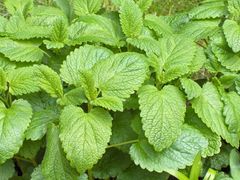Lemon balm
| Melissa officinalis subsp. var. | ||||||||||||||||||||||||||||||||||||||||||||||||||||||||
|---|---|---|---|---|---|---|---|---|---|---|---|---|---|---|---|---|---|---|---|---|---|---|---|---|---|---|---|---|---|---|---|---|---|---|---|---|---|---|---|---|---|---|---|---|---|---|---|---|---|---|---|---|---|---|---|---|

|
|
| ||||||||||||||||||||||||||||||||||||||||||||||||||||||
| ||||||||||||||||||||||||||||||||||||||||||||||||||||||||
Lemon balm (Melissa officinalis), not to be confused with bee balm, Monarda species, is a perennial herb in the mint family Lamiaceae, native to southern Europe and the Mediterranean region.
It grows to 70-150 cm tall. The leaves have a gentle lemon scent, related to mint. At the end of the summer, small white flowers full of nectar appear. These attract bees, hence the genus name Melissa (Greek for 'honey bee').
| Standard Cyclopedia of Horticulture |
|---|
|
Balm (Mellisa officinalis, Linn.). Labiatae. Lemon Balm and Bee Balm. Sweet herb, the Lvs. being used for seasoning, particularly in liquors, and also in medicine. It has a lemon-like flavor. It is a hardy perennial from S. Eu. The plant grows 1-2 ft. high, somewhat hairy, loosely branched, with ovate-petioled, sometimes cordate, Lvs. and yellowish or whitish fls. in loose axillary clusters. Thrives in any warm position, and is easy to grow. Prop, by seeds; also by division. Becoming wild in E. U.S.
|
Cultivation
This herb can be easy to cultivate in United States Department of Agriculture Plant Hardiness Zones 4 to 9. In zone 4, it needs winter mulch and a well-drained sandy soil to survive. In zone 7, it can be harvested at least until the end of November. While it prefers full sun (as described on most plant tags), it is moderately shade-tolerant, much more so than most herbs. In dry climates, it grows best in partial shade. It can also be easily grown as an indoor potted herb.
Lemon Balm requires light and at least 70 degrees Fahrenheit to germinate so it is best to plant indoors or in spring and not to cover the seeds.
Lemon Balm grows in clumps and spreads vegetatively as well as by seed. In mild temperate zones, the stems of the plant die off at the start of the winter, but shoot up again in spring. It can be easily grown from stem cuttings rooted in water, or from seeds. Under ideal conditions, it will seed itself prolifically and can become a nuisance in gardens.
Propagation
Pests and diseases
Varieties
Gallery
-
Leaves
-
Leaves
-
Plant
References
- Standard Cyclopedia of Horticulture, by L. H. Bailey, MacMillan Co., 1963
External links
- w:Lemon balm. Some of the material on this page may be from Wikipedia, under the Creative Commons license.
- Lemon balm QR Code (Size 50, 100, 200, 500)




